Best Full-Frame Cameras for Beginners in 2024
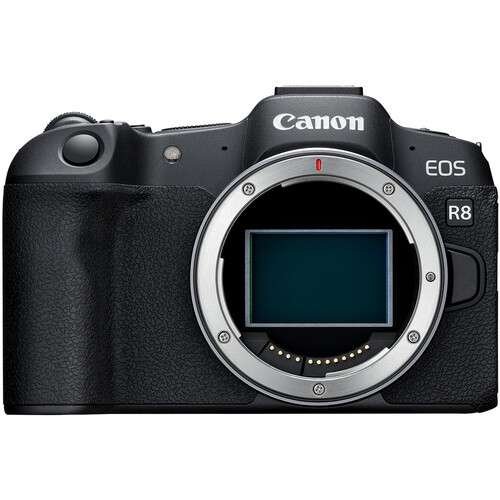
When delving into the realm of full-frame cameras, the assumption often arises that exceptional quality comes with a hefty price tag. Fortunately, this is not always the case. Surprisingly, you can lay hands on a superb full-frame camera for less than $1,500 / £1,500. With a willingness to explore older models, sift through the second-hand market, and exercise patience, affordable options abound. Our guide is designed to point you towards the best-suited models without breaking the bank.
In our pursuit of value, we cast a wide net, considering both DSLRs and mirrorless cameras. Canon, Nikon, Pentax, Sony, Panasonic, and Sigma offer a plethora of choices in these formats, all of which are represented in our comprehensive guide.
For the uninitiated, ‘full-frame’ refers to the size of a camera’s imaging sensor. With dimensions measuring 36x24mm, akin to a single frame of 35mm film, full-frame sensors hold a distinct advantage. They surpass smaller sensor types such as APS-C, Four Thirds, and 1-inch in both physical size and performance, boasting greater dynamic range and avoiding cropping issues. This advantage extends to videography, making full-frame cameras a preferred choice for burgeoning content creators.
Whether you’re capturing stunning stills or diving into the world of video production, these entry-level full-frame cameras offer an enticing blend of performance, affordability, and versatility.
Best Full-Frame Cameras for Beginners in 2024
1. Canon EOS R8

Canon EOS R8 Key Specifications:
- 24.2MP Full-Frame CMOS Sensor
- Dual Pixel CMOS AF II
- 4K/60p video oversampled from 6K
- 10-bit C-Log3 or HDR PQ video capture
- 2.36m-Dot OLED Electronic Viewfinder
- 3.0″ 1.62m-Dot Vari-Angle Touchscreen
- Up to 40fps continuous shooting with e-shutter (6fps with mechanical)
- 30fps Raw Burst mode with 1/2-second pre-buffering
- Vertical Movie Mode
- Microphone Input, Headphone Output
- Weight: 414 g (Body Only)
- Store links at B&H, Adorama.
Pros:
- 4K/60p video recording
- No crop on 4K Videos
- 40fps electronic shutter
- Excellent AF subject tracking
- Incredibly light and compact
Cons:
- No in-body stabilization
- The viewfinder is lower resolution
- No AF joystick
- Only one card slot
- Low Battery Life: 290 shots
The Canon EOS R8 Mirrorless Camera stands out as a lightweight and travel-friendly option, offering an impressive array of features tailored for both photographers and multimedia content creators. Despite its compact form, this camera packs a punch with its full-frame 24.2MP CMOS sensor and DIGIC X image processor, enabling 6K oversampled UHD 4K 60p video recording and Full HD 1080 180p slow-motion playback, along with a remarkable continuous shooting speed of up to 40 fps.
Positioned between the higher-end R6 II and the entry-level RP, the Canon EOS R8 inherits the sensor prowess of the former while adopting a simpler, lighter body akin to the latter. This strategic positioning allows it to deliver exceptional photo, video, and autofocus performance at a more accessible price point. To achieve this affordability, some compromises were necessary, such as the omission of IBIS and 6K RAW video recording found in the R6 II. Additionally, the R8 features a single card slot, a lower-resolution viewfinder, lack of joystick or rear wheel controls, a slower mechanical shutter, and a smaller battery capacity.
Although the absence of IBIS may disappoint some users, especially considering its inclusion in the R6 II, the Canon EOS R8’s significantly lower price makes these sacrifices more palatable. In Canon’s lineup, the EOS R8 strikes a harmonious balance between features and affordability, presenting an enticing option for existing R and RP owners seeking an upgrade, as well as those transitioning from earlier DSLR or APS-C models. Overall, the Canon EOS R8 represents a compelling choice that combines performance, portability, and value for a wide range of users.
Canon EOS R8 body at B&H, Adorama.
Canon EOS R8 with 24-50mm Lens at B&H, Adorama.
2. Panasonic Lumix S5 II
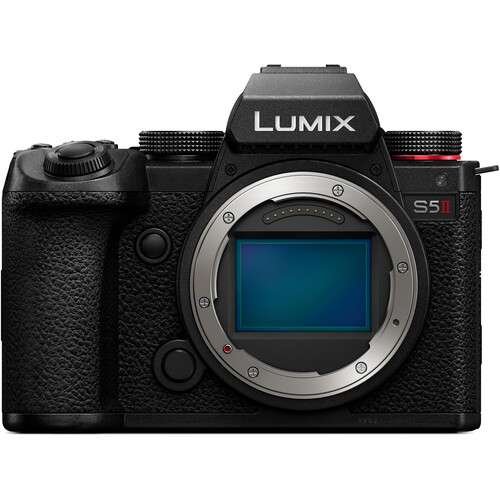
Panasonic Lumix S5 II Key Specifications:
- 24.2MP Full-Frame CMOS Sensor
- 6K30p 4:2:0 10-Bit Video Recording
- C4K/4K60p 4:2:2 10-Bit Unlimited
- 3.68m-Dot 0.78x-Magnification OLED LVF
- 3.0″ 1.84m-Dot Tilt/Free-Angle Touch-LCD
- 779-Point Phase-Detection AF System
- 5-Axis Sensor-Shift Image Stabilization
- ISO 100-51200, up to 30 fps Shooting
- Dual UHS-II SD Slots; Wi-Fi & Bluetooth
- Weather-Sealed Construction
- Weight: 658 g (Body Only), 744 g (With Recording Media)
- Store links at B&H, Adorama.
Pros:
- Enhanced video capabilities suitable for professional use
- Unlimited recording duration for extended filming sessions
- Film-like image quality elevates visual storytelling
- Best-in-class stabilization ensures smooth footage
- Dual SD card slots offer redundancy and increased storage capacity
- Remarkable value proposition considering the feature set
Cons:
- Average battery life
The Panasonic LUMIX S5 II boasts a myriad of impressive features that make it a standout choice for videographers and content creators alike. Its stellar video performance, coupled with the convenience of dual SD card slots and weather-resistant body, renders it a compelling option in its class. Notably, it supports 6K30p video recording with 4:2:0 10-bit for up to 30 minutes, and DCI and UHD 4K60p 4:2:2 10-bit unlimited video recording, setting a new standard for quality within its segment.
For those immersed in the world of content creation or YouTube, the Panasonic LUMIX S5 II emerges as an obvious choice. From its impressive video output to the efficacy of its 5-axis dual image stabilization, this camera can hold its own against much pricier alternatives. Moreover, the inclusion of dual SD card slots proves invaluable for recording lengthy videos or short films, providing both redundancy and expanded storage capacity.
Even with the bundled 20-60mm kit lens, which may not be the fastest, users can still enjoy a versatile range of focal lengths. Whether capturing wide-angle videos or portrait shots, beginners need not worry about investing in additional lenses right away. Reviews affirm that the Panasonic S5 II offers excellent value for its price, particularly excelling in video applications. However, it’s worth noting that its battery life is average, necessitating the purchase of extra cells to ensure uninterrupted shooting sessions.
In summary, the Panasonic LUMIX S5 II stands out for its enhanced video capabilities tailored for professional use, unlimited recording duration, and film-like image quality conducive to compelling visual storytelling. Its best-in-class stabilization ensures smooth footage, while dual SD card slots provide both redundancy and increased storage capacity. Despite its average battery life, the camera’s remarkable value proposition, coupled with its feature-rich design, solidifies its position as an excellent choice for videographers at any level.
Panasonic Lumix S5 II body at B&H, Adorama.
Panasonic Lumix S5 II with 20-60mm Lens at B&H, Adorama.
3. Sony a7C
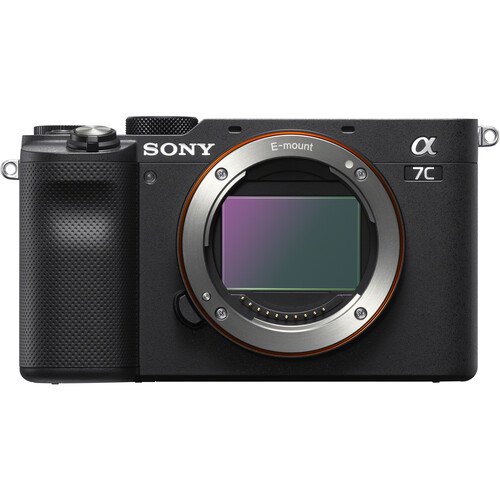
Sony a7C Key Specifications:
- 24.2MP Full-Frame Exmor R BSI Sensor
- BIONZ X Image Processor
- UHD 4K30p Video with HLG & S-Log3 Gammas
- 693-Point Hybrid AF System
- 2.36m-Dot OLED Electronic Viewfinder
- 3.0″ 921.6k-Dot Vari-Angle Touchscreen
- 5-Axis In-Body Image Stabilization
- Shooting Up to 10 fps, ISO 50-204800
- Bluetooth and Wi-Fi Connectivity
- Weight: 1.1 lb / 509 g (With Battery, Recording Media)
- Store links at B&H, Adorama.
Pros:
- Tiny and lightweight body
- Powerful 5-axis in-body image stabilization
- Useful fully articulated screen
- Superlative tracking autofocus
- Excellent battery life
- Great overall video quality
Cons:
- Small EVF
- Lacks front dial and other controls
Priced similarly to the Panasonic S5 II, the Sony a7C offers a compelling alternative with its compact form factor, enhanced lens system, and exceptional autofocus performance, albeit at a slightly higher premium.
In terms of size, the Sony a7C reigns supreme as the most compact full-frame camera in its class. Its diminutive stature often leads users to mistake it for an APS-C camera, highlighting its impressive portability without sacrificing functionality.
Critics unanimously praise the a7C’s autofocus capabilities, noting its proficiency both in still photography and video recording scenarios. Moreover, the built-in In-Body Image Stabilization (IBIS) proves its worth, particularly in low-light conditions, although some reviewers suggest that video stabilization could be improved, necessitating the use of a separate gimbal for serious videography endeavors.
Where the Sony a7C truly shines is in its battery life, surpassing the performance of the LUMIX S5 II by a considerable margin. This enhanced longevity is a significant boon, especially considering the camera’s compact dimensions.
For photographers and videographers seeking a versatile, high-performance full-frame camera that excels in both stills and video capture, while maintaining an ultra-compact profile, the Sony a7C emerges as an irresistible choice that’s difficult to overlook.
Sony a7C body at B&H, Adorama.
Sony a7C with 28-60mm Lens at B&H, Adorama.
4. Nikon Z5

Nikon Z5 Key Specifications:
- 24MP full-frame CMOS sensor (not BSI)
- 5-axis in-body image stabilization
- 4.5 fps continuous shooting with AF
- 4K/30p video capture (with 1.7x crop)
- 1080/60p video capture (no crop)
- 3.69M-dot OLED viewfinder
- Dual UHS-II SD cards
- Headphone and microphone ports
- Dust and moisture sealed
- Weight: 590 g (Body Only)
- Store links at B&H, Adorama.
Pros:
- Rugged build quality
- Dual UHS-II card slots
- 5-axis in-body image stabilization
- Intuitive autofocus
Cons:
- No built-in flash
- 1.7x crop applied to 4K video
- Only 4.5 frames per second in burst shooting mode
The Nikon Z5 is a highly recommended full-frame mirrorless camera that offers an excellent balance of features and affordability, making it an ideal choice for beginners or those looking to upgrade from an APS-C camera. With a 24.3-megapixel full-frame sensor and the powerful EXPEED 6 image processor, the Z5 delivers impressive image quality and performance.
One of the standout features of the Z5 is its electronic viewfinder (EVF). With a 3.6m-dot OLED EVF, it provides a clear and immersive view for composing and exposing your images. The camera also supports 4K video recording, although with a 1.7x crop, and offers Full HD at 60 fps with no crop. The autofocus system is fast, responsive, and easy to use, with Face and Eye AF for both people and animals.
While the Z5 may not offer the same low-light performance as the slightly more expensive Nikon Z6, it compensates with 5-axis in-body image stabilization (IBIS), providing up to five stops of stabilization for sharper shots at slower shutter speeds. Additionally, the camera boasts a fully weather-sealed body, ensuring durability and protection against the elements.
The Nikon Z5 is a versatile camera that excels in stills photography. It offers great image quality, reliable autofocus, and a weather-sealed body. However, video shooters may find the 4K video heavily cropped, and the burst rate of 4.5 fps may not be sufficient for capturing super-fast action.
Overall, the Nikon Z5 is an outstanding full-frame mirrorless camera that offers a well-rounded feature set and excellent image quality at an accessible price point. It is a great option for beginners or photographers looking for an affordable entry into the full-frame mirrorless market.
Nikon Z5 body at B&H, Adorama.
Nikon Z5 with 24-50mm Lens at B&H, Adorama.
5. Canon EOS RP
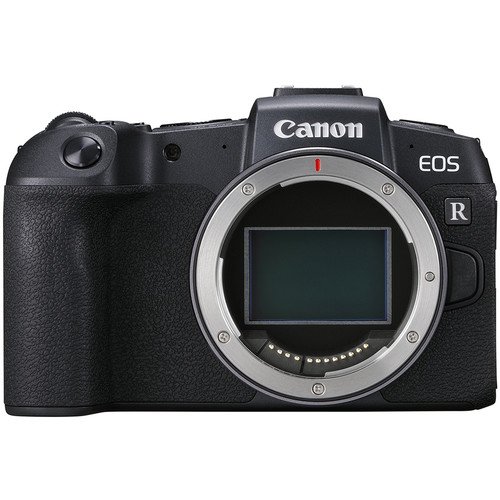
Canon EOS RP Key Specifications:
- 26.2MP Full-Frame CMOS Sensor
- DIGIC 8 Image Processor
- UHD 4K and Full HD 1080 Video
- 2.36m-Dot OLED Electronic Viewfinder
- 3″ 1.04m-Dot Vari-Angle Touchscreen LCD
- Dual Pixel CMOS AF, 4779 AF Points
- ISO 100-40000, Up to 5 fps Shooting
- Wi-Fi and Bluetooth Connectivity
- Weight: 485 g (With Battery, Recording Media)
- Store links at B&H, Adorama.
Pros:
- Compact and portable design
- Outstanding autofocus capabilities
- Impressive high-ISO performance
Cons:
- Limited stabilization functionality restricted to videos
- Lack of in-body stabilization
- Costly lens options
The Canon EOS RP sits in a similar price bracket as the Sony a7 II, yet Canon opts not to bundle it with a kit lens, requiring an additional investment. However, the higher price tag comes with a notable advantage: 4K recording capability, a boon for burgeoning content creators.
Renowned for its compactness, the EOS RP stands out as one of Canon’s most petite mirrorless offerings. Its portability makes it an ideal companion for travel photography, allowing enthusiasts to capture stunning moments on the go. Reviews consistently highlight its prowess in travel and street photography, attributing its success to crisp image quality and reliable autofocus performance.
Nevertheless, users should maintain a steady hand when shooting in low-light conditions, as the in-body image stabilization is exclusively tailored for video recording. Despite this limitation, the EOS RP earns praise as an entry-level camera for individuals venturing into both photography and videography realms.
Potential buyers should factor in the cost of RF lenses, which can be somewhat steep. Nonetheless, considering its compact design, exceptional autofocus, and commendable high-ISO performance, the EOS RP remains a compelling option in the budget full-frame camera market.
Canon EOS RP body at B&H, Adorama.
Canon EOS RP with 24-105mm f/4-7.1 Lens at B&H, Adorama.
6. Sony a7 II
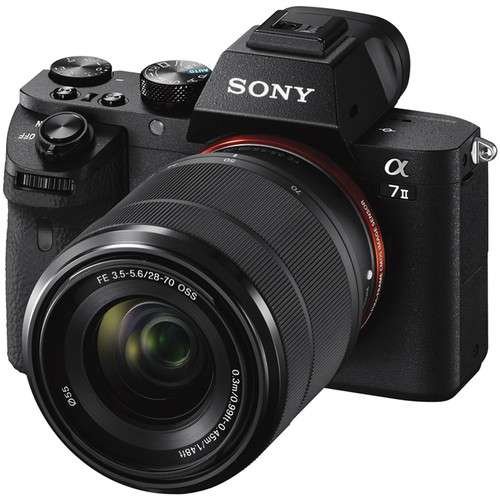
Sony a7 II Key Specifications:
- 24.3MP Full-Frame Exmor CMOS Sensor
- 5-Axis SteadyShot INSIDE Stabilization
- Enhanced Fast Hybrid AF and 5 fps Burst
- Full HD XAVC S Video and S-Log2 Gamma
- 3.0″ 1,229k-Dot Tilting LCD Monitor
- XGA 2.36M-Dot OLED Electronic Viewfinder
- Weather-Resistant Magnesium Alloy Body
- Weight: 556 g (Body Only), 599 g (With Battery, Recording Media)
- Store link at B&H.
Pros:
- Budget-friendly pricing
- 5-axis stabilization for steady shots
- Durable, weather-sealed construction
Cons:
- Lack of 4K video recording capability
- Moderate shooting speed compared to competitors
- No silent shutter option
The Sony a7 II stands out among the array of budget-friendly full-frame cameras, offering unparalleled value for its price point. Boasting a superbly crafted body, this camera not only delivers exceptional build quality but also includes a versatile kit lens, all without breaching the four-digit price threshold.
Despite its age, the Sony a7 II remains a formidable contender in the realm of photography, thanks to its expansive sensor that consistently captures stunning imagery. Enhanced by its 5-axis in-body stabilization, this camera excels even in challenging low-light conditions, ensuring crisp and blur-free shots. Its built-in stabilization also lends stability to video recording, making it a favored choice among aspiring content creators.
However, a notable drawback of the Sony a7 II is its absence of 4K video recording capability. While this may not be a concern for pure photography enthusiasts, videographers may find this limitation restrictive over time.
For those on a strict budget under $1000 and prioritizing 4K recording, the Canon EOS ROP presents a viable alternative. Nevertheless, in terms of photography prowess, the Sony a7 II continues to impress users even years after its initial release. With its sharp image quality and ergonomic design, it remains a dependable choice for photographers seeking reliability in their gear.
Sony a7 II with 28-70mm Lens: $998 at B&H.
All of the top recommended full-frame cameras for beginners listed above are capable of delivering exceptional photo and video quality. Whether you’re delving into photography as a hobby or considering embarking on a freelance photography venture, these cameras offer a perfect balance of performance and affordability, ensuring you can achieve outstanding results without straining your budget.
Read more:
- Best Cameras Under $400
- Best Cameras for Beginners
- Best Cameras for Wedding Photography
- Best Sony Cameras for Video
- Best GoPro Cameras